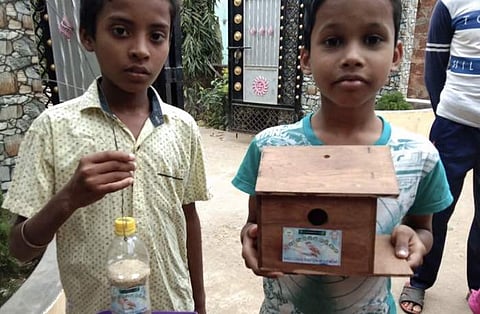

The district of Nayagarh in Odisha is teeming with sparrows, thanks to the efforts of Odisha Paryavaran Sanrakshan Abhiyan (OPSA), Puri who collaborated with Friends Help Group from 10 villages of Nayagarh for this very purpose. OPSA is the same organisation which is already doing back-breaking work for the conservation of Olive ridley turtles in Odisha. Recognising that all wildlife, in one way or the other, contribute to the ecosystem, they decided to work for sparrow conservation too. "We had in fact planned a huge event today, it being World Sparrow Day. We wanted to install 500 nests made of earthenware for sparrows with the help of volunteers and citizens, but due to the Coronavirus scare, we had to push it back," says Soumya Ranjan Biswal.
It takes a village
It was when Soumya and a few others visited villages in Nayagarh that they met a group of youngsters there. "The team there was already involved in tree plantation activities and were telling us about how they hardly see any sparrows anymore. That's when we decided to team up with them and work for sparrow conservation," says Soumya. They involved the officials of the forest department to zero in on the spots to place nests at. The next step though was more challenging — finding the right nests. They ordered about 100 nests from Nature Forever Society, which was started by Mohammed Dilawar, the Sparrow Man of India who has been working in the field of conservation for over 13 years. "But the boxes are made out of wood and hence, temperature control was poor which makes breeding for sparrows difficult. That is why we decided to make nests from earthenware," he explains.
The right home
The nests have entry points small enough that only a sparrow can enter, which keeps other birds away from them. They are set up in balconies and in front of homes. Bird feeders are also set up about a metre away from the nests. "But we don't want the sparrows to depend on the feeders. That disturbs the ecological balance as sparrows usually eat pests that helps the agricultural fields. We remove the feeder once we notice that the sparrow has made itself at home in a nest," Soumya says. They installed nests in two phases. In the first phase, they set up about 65 nests and in the next one, they set up about 35.
They wish to begin conservation activities in urban areas like Bhubaneswar soon and hope that the government and the forest officials take the conservation of forests more seriously.
Scenes from their campaign
